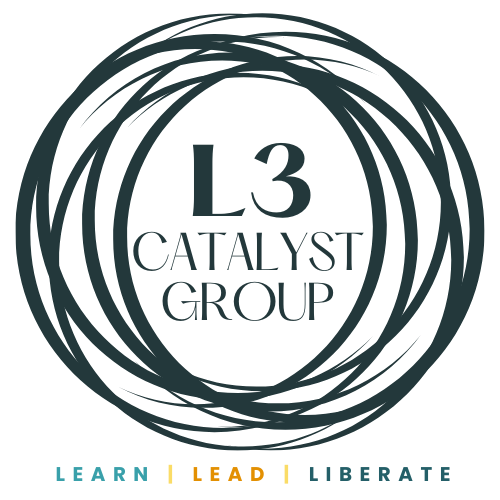From Perception to Impact: Understanding Leadership Identity
Today, we hear from Scott Hackman, a brilliant, brave, and badass human who has taken time to intentionally explore his identity as a leader.
At least once a month in 2024, we will hear from humans who help us see learning, leadership, and liberation in new and everyday ways, holding the precious truths and focusing our eyes to see.

Heartfelt thanks to you, Scott, for sharing your wise reflections with us.
Fellow leaders and learners, I wish you courage, rest, and beloved community along the journey.


Leading a team is like being on a rollercoaster – thrilling highs of success and tough lows of conflict. In these stressful moments, our true selves shine. We can't eliminate hard moments from work, but we can control how we react, guided by our leadership identity.
A clear leadership identity is key to leading well, guiding our choices, and keeping us on track. This article explores leadership identity – what it means, how it shapes our work and team, and ways to develop it.
What is leadership identity?
Your leadership identity embodies the culmination of your actions, beliefs, principles, personality traits, and values, crafting a unique leadership style tailored to you. It's not a one-size-fits-all model; instead, it's a deeply personal and evolving concept.
Two primary aspects of leadership identity merit consideration. Firstly, there's self-perception, which explores how you view yourself. Your interactions with tasks, responsibilities, and roles shape this self-perception.
For example, while evolving my leadership identity, I see myself as a creative idea generator and opportunity creator. I recognize this because my work consistently yields high-value results in those areas. However, I've noticed a tendency to overlook administrative tasks like making calls or compiling reports, as they don't align with my perception of leadership responsibilities. This self-awareness enables me to improve my work efficiency by wisely distributing my energy among tasks and reaching out for help when needed.
The second aspect of leadership identity is reputation, which is how others perceive your leadership. I highly recommend using Hogan assessments. They provide objective data, offering valuable insights into your leadership style and impact.
In exploring the components of your leadership identity, it's important to recognize its deeply personal nature. Factors such as gender, race, sexuality, ability, and more all contribute to shaping who we are as leaders. While some environments celebrate these diversities in leadership, others may pressure individuals to conform or suppress their unique identities.
 When the right time and environment align, embracing the personal aspects of your leadership identity can be incredibly empowering. These elements have the potential to create strong bonds among you, your team, and other stakeholders, fostering mutual influence and focused efforts.
When the right time and environment align, embracing the personal aspects of your leadership identity can be incredibly empowering. These elements have the potential to create strong bonds among you, your team, and other stakeholders, fostering mutual influence and focused efforts.
By standing firm in your beliefs and expressing yourself authentically and passionately, you not only affirm your own identity but also cultivate a company culture that values inclusivity, psychological safety, and holistic care for everyone as a whole person.
How does leadership identity affect your work and organization?
Your leadership identity is crucial for increasing your capacity and meeting the current and future demands of leadership for your organization. To be specific, leadership identity can:
- Impact your feelings and efficiency on tasks: We all have preferences, strengths, and areas where we may struggle. A clear awareness of your leadership identity can guide you to prioritize tasks according to what energizes you most, thus enabling you to structure your days more fulfillingly.
- Affect collaboration: When you clearly understand your strengths and areas for growth, you can effectively communicate your expectations and goals, setting a positive example for collaboration. Additionally, when you honor and appreciate each team member's diverse talents and contributions, you cultivate a culture of inclusivity and teamwork.
- Help avoid wasting organizational resources: When leaders prioritize their strengths and acknowledge their areas needing support, the organization avoids cleaning up after them, compensating for their shortcomings, or simply fulfilling the leader’s self-indulgence. For example, I may generate ideas relentlessly, but without my business partner's input, those ideas may lack direction or fail to address real problems. Few people tolerate self-indulgent leadership today, highlighting the importance of collaborative and resource-conscious leadership.
- Strengthen your credibility: Being genuine and transparent about who you are and what you stand for creates connections and trust. When your leadership identity guides decisions in line with your values, it shows reliability and consistency, further building trust among team members, stakeholders, and peers.
How do you develop your leadership identity?
Let's revisit the two aspects of your leadership identity: self-perception and how others perceive you. Other's perception of you can be broken down into two key components: persona and reputation. Specifically, there are four main steps to consider:
 Enhance your self-perception: Dedicate time to introspection, reflecting on your strengths, values, and the type of leader you aspire to be. Utilize assessments to deepen your self-awareness, and take proactive steps such as making adjustments, communicating your identity, and seeking support in your work to cultivate credibility and accountability.
Enhance your self-perception: Dedicate time to introspection, reflecting on your strengths, values, and the type of leader you aspire to be. Utilize assessments to deepen your self-awareness, and take proactive steps such as making adjustments, communicating your identity, and seeking support in your work to cultivate credibility and accountability.- Craft your persona authentically: As you establish credibility and accountability, you have crafted a persona. Think of it as a suit that guides your actions, responsibilities, and interactions in alignment with your values and aspirations.
- Build your reputation and seek feedback: You naturally develop a reputation as you interact with others. Actively engage with others and seek feedback from peers, mentors, and team members to understand how your reputation is perceived. Embrace constructive feedback as a valuable tool for growth and refinement.
- Utilize feedback for self-reflection and refinement: Reflect on the feedback received and use it to refine your self-perception. Continuously iterate on this process to grow and evolve your leadership identity.


What is Scott Reading, Watching, or Listening to?
- Watching: Bluey, Last Week Tonight
- Listening to: Sunny Day Real Estate, Beyonce, Pearl Jam, and Low Fi Beats on Spotify
- Reading: Myth of Normal by Gabor Maté and Buddha Brain by Dr. Richard Hansen


April 30, 2024




Comments